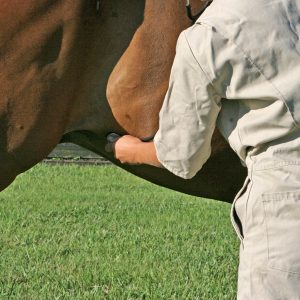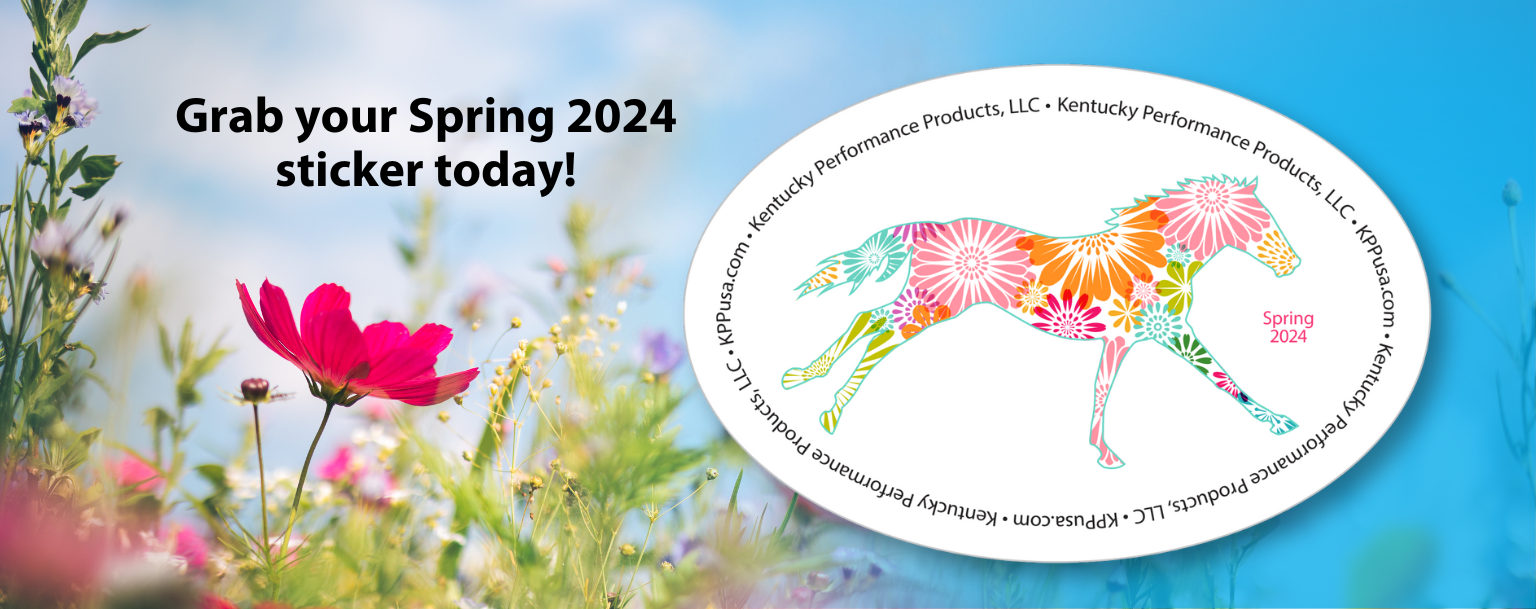
Horse Gut Sounds and What They Mean
One way to determine if your horse is normal and healthy is to evaluate the rumblings of his gut. The technical term for a gut sound is a borborygmus (pronounced bôr′bə-rĭg′məs). The plural is borborygmi. During a physical exam a veterinarian will listen to your horse’s gut sounds with a stethoscope in the flank area to determine if normal borborygmi are present. When listening for gut sounds, both sides of the horse are evaluated and the abdomen is divided into four areas or quadrants. A healthy horse will have consistent and active rumblings in each of the four quadrants. Each area should be evaluated for at least one minute. As a general rule, it is normal to hear 1 to 3 borborygmi in a 60-second period. If less than 1 borborygmus is heard per minute then that portion of the gut is noted as hypomotile (not enough movement). If more than 3 borborygmi are heard per minute the area is noted as hypermotile (too much movement). Of course, there are variations depending on the individual horse and when he or she last ate.
Typically when a horse presents with impending enterocolitis, which often results in diarrhea, he will have a hypermotile gut with increased liquid and gas sounds. Hypermotility can be present in the early stages of obstructive disease. Hypomotility, however, is the sign of a poor gut movement and an absence of gut sounds may indicate the presence of an obstruction.
What lies below the stethoscope?
The upper left quadrant of the horse’s flank overlies the pelvic flexure of the large intestine and small colon. Referred sounds from the stomach and small intestine can be heard, depending on gut fill. This quadrant can be quieter than others because it typically contains smaller quantiles of fluid and gas, but sounds should still be present.
The lower left quadrant overlies the left upper and lower colon. The upper right quadrant overlies the base of the cecum, and the lower right quadrant overlies the body of the cecum. Constant motility and large quantities of fluid and gas are expected to be found in these quadrants. Sounds should be consistent and of a greater intensity than those heard in the upper left quadrant.
It can be helpful for owners to learn how to listen for gut sounds and to know what is normal for their horse. It is important to become familiar with some of the other passive sounds that might be heard in the gut so as not to mistake them for proper intestinal function. Ask your veterinarian to help you learn how to use and position the stethoscope properly and what to listen for. Check your horse periodically to learn what is normal for him or her. Borborygmi alone cannot be used to identify an illness; a complete physical exam and the review of other symptoms are necessary to properly diagnose and treat diseases of the gastrointestinal tract.



6 Comments
My horses stomach is making a sound that sounds like “hoop” when he is cantering or trotting
This sound you are hearing is actually not coming from your horse’s belly, but from his sheath. It is usually heard at the trot, but may also occur at the canter. This is more commonly heard with geldings, but occasionally a mare can make this noise as well.
This “hoop” or groan is thought to be caused by tension in the back and abdominal muscles, which allow air to be sucked up into the sheath or udder. A long, slow warm-up, coupled with exercises that help the horse to relax and stretch, may help this condition.
I’m taking care of a neighbors mare who is 20. She has lost a lot of weight so our neighbor asked if we would care for her. She had profuse scores. She is a little better but in the month since we have been taking care of her we have been feeding her good hay and Neutra Complete Horse feed, 2 scoops a day. One in the am and one in the pm.
She still doesn’t look to be really putting on weight. Her ribs look better but she still is thin in the rear. We are also giving her Kaolin Pectin and are on the last of 2 gallons. Our neighbor don’t want to call a vet in so any suggestions on how we could get some weight on her would be greatly appreciated.
Hi Cris,
It sounds like you are going in the right direction if you see some weight gain. It could be this mare just needs more calories, or she could have an underlying health problem. There are several diseases that make it hard for horses to put weight over their topline.
When a horse is skinny it is usually caused by one or more basic issues. It can be one problem or a combination of problems. The four most common causes of weight loss are as follows.
(1) Lack of adequate calories in the diet.
(2) Dental problems that make it hard for a horse to chew properly (often seen in older horses).
(3) A parasite load that is too high.
(4) An underlying health condition that makes it hard for a horse to maintain condition.
First, make sure your horse is getting enough calories.
Horses should be eating 1.5% to 2% of their body weight per day in good forage. That means a 1,000 lb horse should get 15 to 20 lbs of hay per day. If a horse is bigger, they will need more hay.
Keep in mind that a mature grass hay will be less calorie-dense than a less mature hay or a mixed hay. Sometimes changing to a mixed hay (grass and alfalfa or grass and clover) will provide enough calories to fatten up a hard keeper. Always add new hay slowly over a period of 7 to 10 days.
Your choice of feed is a good place to start, but without knowing how much your scoop of Nutrena Triumph Complete Horse Feed weighs is it hard to tell if 2 scoops per day is an adequate amount. I suggest you weigh a scoop of the feed so you know how much you are feeding in pounds.
You also need to be aware that the NSC value (starch and sugar in the feed) of Nutrena Complete is 22%. If this mare has PPID (Cushing’s disease ) she may require a feed with a lower NSC value, 10% or less. One of the symptoms of PPID is loss of muscle mass over the back and rump. PPID is a common disease in older horses. Horses with PPID should be on a low-sugar feed. To learn more about PPID, read this article: http://kppusa.com/2013/03/05/horse-health-tidbit-managing-ppid/. You should rule this out before feeding this mare large amounts of Complete.
According to the manufacturer, the minimum recommended amount of Complete for a 1,000 lb horse is 3 lbs; the maximum amount is 12 lbs. This is a high-fiber complete feed so it is formulated and safe to feed in larger quantities to horses that are not sugar sensitive. When feeding larger amounts, feed no more than 4 lbs at a time and allow at least 6 hours between feedings. A horse that needs to gain weight may require more than a maintenance amount to reach their target weight. Once the target weight is achieved, you can slowly decrease the feed to an amount that maintains the horse at the desired weight.
If you decide to increase the amount of Complete, do so slowly over 7 to 10 days and add a meal at noon or later at night if necessary. Do not feed more than the maximum recommended amount.
Another option is to add a high-fat supplement to the horse’s diet. Kentucky Performance Products has two available: Equi-Jewel rice bran (19% fat) (http://kppusa.com/product/equi-jewel/) and EndurExtra (50% fat). (http://kppusa.com/product/endurextra/) Feeding a high-fat supplement allows you to provide more calories without having to feed large amounts of grain, which is a healthier alternative for many horses. Fat supplements are safe for sugar-sensitive horses. Feed according to the directions on the bag. As with any new feed, start slowly and increase to the desired amount over 5 to 7 days.
Second, have you or her owner had her teeth checked and floated? Some seniors need their teeth floated more often! Horses with poor teeth get little nutritional value out of the food they are eating because they can’t chew it.
Third, take a fecal sample to see if your horse needs to be dewormed. Even horses on a routine deworming schedule can have a heavy parasite load. Parasites have becoming resistant to some of the dewormers we use today.
Finally, even though the owner doesn’t want to get the vet involved, I strongly recommend this mare have a checkup. There are many diseases common in older horses that can cause weight loss and muscle loss. Ruling out and treating existing issues will make it easier to help her maintain a healthy weight. Also, you said you were feeding her Kaolin Pectin for diarrhea. Did that help? If she still has diarrhea then you definitely want to consult with a veterinarian to get a proper diagnosis and set up a treatment plan.
My horse stomach growls even when she is full is this normal
This is completely normal. A healthy horse will have consistent and active rumblings!